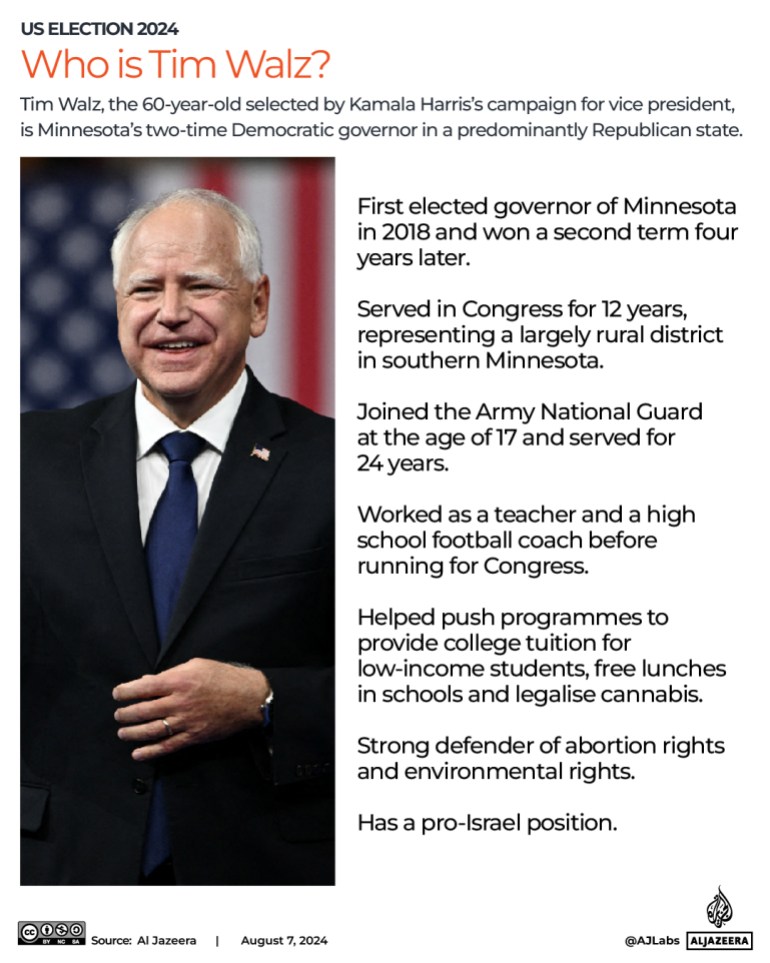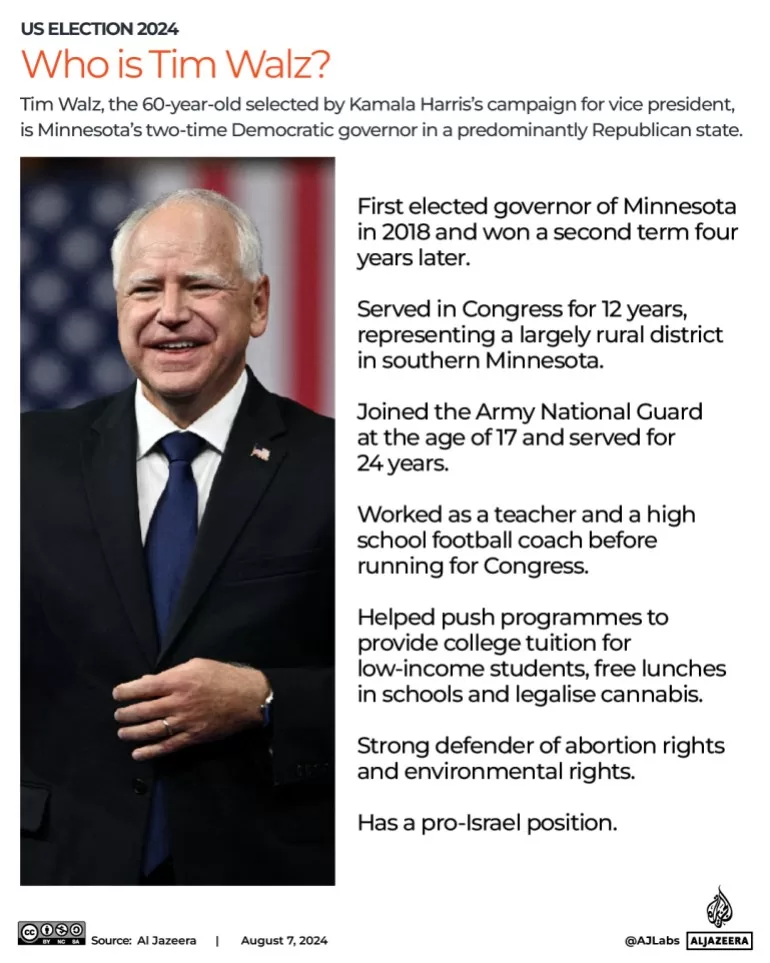Washington, DC – In the United States political circles, conventional wisdom dictates that voters only care about the candidate atop the presidential ticket, not the running mate.
While vice presidential picks can play a role in public opinion, voters cast ballots mostly for the headliners — or so the argument goes.
In the 2024 presidential race, that means much of the attention will fall to Vice President Kamala Harris and former President Donald Trump, the Democratic and Republican nominees, respectively.
But as Harris zips across the country on a campaign blitz, she is poised to put that logic to the test.
She is campaigning side by side with her newly minted running mate, Minnesota Governor Tim Walz, stopping in the battleground states of Wisconsin and Michigan on Wednesday.
Democratic strategists say Harris’s selection of Walz is part of an effort to pull ahead in a neck-and-neck presidential race.
His avuncular personality, progressive messaging and middle-class Midwestern roots seem well-suited to answer specific Democratic needs: The party needs to shore up its progressive base and shed the shroud of coastal elitism if it hopes to reclaim the White House in November.
But take that optimism about Walz with a grain — or a shaker full — of salt, said Allan Lichtman, a history professor at American University.
“You can take all the punditry on the effect of the Walz pick on the election’s outcome and do with it what the great philosopher David Hume said you should do with works of superstition: Consign it to the flames,” Lichtman said.
“There is no evidence that a VP pick influences the outcomes of a presidential election.”
Still, with an unconventional presidential race unfolding, some analysts question how Walz’s selection might be perceived among voters over the long term — and whether he may indeed buoy Harris’s prospects.
An unusual race
Walz’s appointment to the Democratic ticket on Tuesday came as the latest chapter in an unusual campaign season.
Less than three weeks ago, the race seemed destined to pit two of the oldest nominees in presidential history against one another on election day: Trump and the incumbent president, Democrat Joe Biden.
Trump had already notched his share of firsts during the presidential race. In May, the Republican leader became the first US presidential candidate ever to be convicted on criminal charges. He is also the only former president in recent history to mount a serious effort to overturn a previous election loss.
But a new twist in the election saga came on July 21, when President Biden dropped out of the race after mounting concerns about his age.
Biden had been the Democratic frontrunner. Never in modern history had the presumptive nominee dropped out so late in the race. His decision upended the Democratic ticket with just months until the vote.
But Biden’s departure paved the way for Vice President Harris to lead the Democratic ticket. Her choice to pick Walz as a running mate came on the same day as she was officially certified to be the party nominee.
Lichtman, the American University professor, explained that Walz ticked a number of boxes for the Harris campaign.
A vice presidential candidate must have at least a rudimentary compatibility with their running mate and a level of experience to show they would be able to fill the president’s seat, Lichtman said. Otherwise, the running mate could reflect poorly on the presidential candidate’s decision-making skills.
Other than that, vice presidential picks are often sidelined or dismissed as less relevant to political campaigns.
Trump himself espoused that view. In July, he selected JD Vance, a 40-year-old senator from Ohio, to be his running mate. But when asked about his decision last week, Trump offered a startling moment of candour.
“Historically, the vice president, in terms of the election, does not have any impact,” Trump said.
“You have two or three days where there’s a lot of commotion as to — like you’re having it on the Democrat side — who it’s going to be. And then that dies down. And it’s all about the presidential pick.”
‘Just enough votes’
Barbara Perry, a professor in presidential studies at the University of Virginia’s Miller Center, acknowledged Trump’s position is “not totally incorrect” historically. But she questioned whether that history will apply in a race that continues to veer into uncharted territory.
Perry added that history has been an unreliable predictor in modern US presidential races, which are increasingly decided by razor-thin margins. In the last six presidential elections, just one race — 2008’s match-up between Barack Obama and John McCain — was decided by more than five percentage points nationally.
In two of those last six elections, the victorious candidates lost the national popular vote, a phenomenon that had not happened since 1888, according to the Council on Foreign Relations.
That includes George W Bush’s win over Al Gore and Trump’s victory over Hillary Clinton in 2016. In both cases, the Republican candidate prevailed over the Democratic one.

Their wins came as a product of the Electoral College system, in which each state represents a certain number of electors. The vast majority of states award all their electors to whichever candidate wins the most votes in the state, no matter how narrowly. The candidate who earns the most electors overall becomes president.
The Electoral College system has been a “concern for Democrats” in recent years, Perry said.
“They can run up the score in the popular vote in places like California and New York and come out millions of votes ahead of the GOP nationally, but the Electoral College is now tipped towards the GOP,” Perry explained.
Harris herself is from California, a solidly blue state. To win the presidency, she needs support in key swing states in the South and Midwest, where a lot of Electoral College votes are up for grabs.
“So getting a vice president who could appeal in Michigan could appeal in Wisconsin — maybe in Pennsylvania and maybe in Arizona as well — [has become a top priority],” Perry said. “Those are key, key battleground states.”
Walz could shore up “just enough votes to help Kamala Harris win”.
Can Walz be a difference-maker?
As with most election predictions, only time will tell if Walz can make an impact on the outcome of the race.
The Minnesota governor had little in the way of a national profile until he emerged on Harris’s short list of possible vice presidential picks.
That list, composed primarily of white men from battleground states, reflected the long-held political trope that a successful presidential ticket must contain a white man as a “balancing” or reassuring force. Harris herself is Black and Asian American.
Kimberly Peeler-Allen, the co-founder of Higher Heights, a group that aims to support Black women in politics, described the strategy as using a white male politician as a “validator” for some voters.
“It’s going to be a long time before we are, as a country, comfortable with having two people of colour on the ticket or even two women, as unfortunate as that is,” Peeler-Allen told Al Jazeera. “But this is a racist, sexist, patriarchal society that we live in, and we can’t escape that.”
American University’s Perry also said the campaign tactic reflects a “paternal view of presidents going back to George Washington” and a legacy of pairing a history-making candidate with a running mate considered more palatable to those wary of change.
She pointed to the 1960 presidential race, which featured John F Kennedy. He was the youngest US presidential candidate ever, and he would go on to be the first Catholic president in the country’s history.
But to “balance” his ticket, Kennedy tapped Texas politician Lyndon B Johnson, a Protestant 11 years his senior, as his running mate.
Walz has also drawn comparisons to Biden, when the latter was tapped as a running mate for Obama’s historic run in 2008. That election saw Obama become the country’s first Black president.
Analysts say both Biden and Walz are seen as charismatic, outspoken older white politicians with ties to battleground states: Pennsylvania in Biden’s case and, in Walz’s, Minnesota.
Born in Nebraska and educated at a state college, Walz’s bona fides as a former high-school teacher, American football coach and military veteran may make him a particularly appealing political asset.
Some analysts see him as an antidote to the Trump campaign’s criticisms that Harris is a “radical liberal” out of step with middle America.
The Harris team has already sought to portray Walz as a champion of the middle class. In their first joint appearance on Tuesday, Harris played up his image as a unifying force.
“Since the day that I announced my candidacy, I set out to find a partner who can help build this brighter future — a leader who will help unite our nation and move us forward, a fighter for the middle class, a patriot who believes, as I do, in the extraordinary promise of America,” Harris said. “I am here today because I found such a leader.”
Walz, in turn, has won attention for his plainspoken manner. He sparked an internet-ready meme when he described the current Republican ticket as, simply, “weird”.
Arshad Hasan, a Democratic political strategist, is among those who see parallels between Walz and Biden.
“The caricature of Uncle Joe is generally a beloved caricature,” Hasan said. “So now we get an Uncle Tim. We’re still seeing something like that on the ticket. This folksy Midwestern charm.”
He believes Walz’s charisma could prove particularly relevant to battleground states like Michigan, Wisconsin and Pennsylvania. Winning the trio of states is considered the surest path to the White House, as has proved the case for Trump in 2016 and Biden in 2020.
Hasan pointed to Walz’s embrace of Midwestern cuisine as something that is resonating with local voters in the region.
“I’m already seeing memes about people bringing hotdish to the Democratic Convention,” he said, referring to a beloved Midwestern casserole.
Party energiser?
Hasan explained that Walz’s entrance into the race may also shore up the diverse segments of the Democratic party.
After all, when Walz was named to the Democratic ticket, both progressives and centrists hailed the decision.
On social media, progressive lawmaker Alexandria Ocasio-Cortez quipped that the Democratic Party was showing “disconcerting levels of array” after months of in-fighting.
That is significant since some political analysts argue that the race may come down to who can turn out their base in the largest number, rather than winning over independent voters or disaffected members of the opposing party.
Hasan described Walz as a skilled communicator of progressive policies and the “preferred choice” of that flank of the party. He also noted that other contenders for the running-mate slot would have roiled certain Democratic interest groups.
Senator Mark Kelly of Arizona, for example, was considered a top candidate to be Harris’s running mate, but he had clashed with labour unions in the past.
Another contender, Pennsylvania Governor Josh Shapiro, had received criticism for his staunch support of Israel’s war in Gaza, which has killed at least 39,677 Palestinians.
In recent months, Shapiro compared pro-Palestine campus protesters to the Ku Klux Klan, making him a non-starter for some Democratic voters.
Previously, as a member of Congress, Walz had also pushed for unconditional aid to Israel, but advocates say they are heartened by his appeals for a Gaza ceasefire.
He has also shown support for the hundreds of thousands of voters who cast “uncommitted” ballots during the Democratic primary season to protest Biden’s stance on Israel.
In a statement on Tuesday, Elianne Farhat, a senior adviser to the “uncommitted” movement, said Walz “has demonstrated a remarkable ability to evolve as a public leader”. She called on Walz to support an arms embargo.
“While his past positions as a Congressman may have conflicted with anti-war voters, we hope he can evolve on this issue as he has on others,” Farhat wrote.
